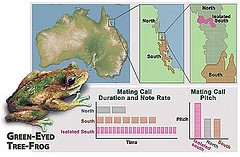(UC Berkeley News)
The yet-to-be-named species arose after two isolated populations of the green-eyed tree frog reestablished contact less than 8,000 years ago and found that their hybrid offspring were less viable. To avoid hybridizing with the wrong frogs and ensure healthy offspring, one group of females preferentially chose mates from their own lineage. Over several thousand years, this behavior created a reproductively isolated population—essentially a new species—that is unable to mate with either of the original frog populations.
Things were purportedly easier (and faster) when these amphibians could turn into bipedal mammals on contact with human saliva, but that’s just another fanciful, discredited tale of divine intervention.


